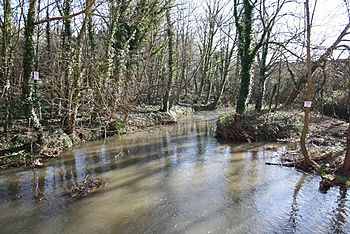River Greet facts for kids
Quick facts for kids Greet |
|
|---|---|

The river downstream of Caudwell Mill, Southwell
|
|
| Country | England |
| County | Nottinghamshire |
| Physical characteristics | |
| Main source | Kirklington |
| River mouth | River Trent Fiskerton 53°3′20″N 0°53′34″W / 53.05556°N 0.89278°W |
The River Greet is a small river located in Nottinghamshire, England. It starts near the village of Kirklington. The Greet then flows southeast, passing by Southwell and Rolleston. Finally, it joins the larger River Trent at Fiskerton.
Contents
River Greet's Water Flow
The River Greet collects water from an area of about 17.85 square miles (46.2 km2). This area is called its catchment. On average, about 6.08 million gallons (27.65 Megalitres) of water flow through the river each day. This measurement is taken at a station in Southwell.
The land around the river above Southwell is mostly made of sandstone. Below Southwell, the ground is mainly mudstone. The river channel itself has a layer of clay, sand, and gravel on top. The river's water levels and clarity are greatly affected by rainfall. Heavy rain can make the water levels rise and the water appear muddy.
Journey of the River Greet
The River Greet begins as several springs west of Kirklington. It is joined by Cotton Mill Dyke and Edingley Beck. East of Kirklington, the river turns to flow southeast. Halam Beck also joins the river from the south.
Old Mills Along the River
There was once a mill at Maythorne Farm. It was built in 1795 to make yarn for knitting. Later, it produced silk and lace thread. A small community grew around the mill, with homes for workers, a shop, and a pub. During the Second World War, soldiers used the building. Today, it has been turned into flats.
Further along, the Robin Hood Way, a long walking path, follows the river. The river forms the northern edge of Southwell. There is a wildfowl centre on the north bank. Caudwell flour Mill is on the south bank. This mill was built where a medieval mill once stood. The Caudwell family owned it for four generations. It closed in 1977 and became flats in 1989.
After leaving the mill, the river flows under the A612 road. It then goes through open countryside to Upton Mill. It passes north of Southwell Racecourse. Then, it turns south, where Rolleston Mill is built over its path. This mill is an old brick building from the late 1700s. It still has some of its original milling equipment inside. The river continues under the Nottingham to Lincoln Line near Rolleston railway station. Finally, it reaches Fiskerton Mill. Just past this mill, it flows under a small road and into the River Trent.
River Greet's Past
In 1598, there was a problem involving millers from Fiskerton, Rolleston, and Upton. They went to Newark to get corn for their mills. However, they were stopped, and their horses were taken to the castle. The corn was taken to "her majesty's mills" to be ground. Eventually, the millers were set free.
The Willoughby family from Wollaton Hall had barges in the 1580s. They delivered coal to Southwell. This suggests that the river might have been wide enough for boats for about 4 miles (6.4 km). People living by the river were responsible for keeping it clean. In 1642, residents of Rolleston, Southwell, and Upton were told off for not doing this job.
Wildlife and Water Quality
The upper parts of the River Greet are home to fish like brown trout (Salmo trutta). Further downstream, you can find coarse fish species. However, changes made to the river channel to help with land drainage have harmed the habitat. This means there are not many fish in these areas.
The Environment Agency manages the river. They have rules about how much water can be taken from the river. This helps protect the environment. In recent years, less groundwater has been taken from the area. This has caused water levels in the river to rise a little.
Water Quality Status
The Environment Agency checks the water quality of rivers in England. Each river section gets an overall ecological status. This status can be high, good, moderate, poor, or bad. They look at things like the number and types of invertebrates, plants, and fish. They also check the levels of different chemicals. Chemical status is either good or fail.
In 2015, the water quality of the Greet and its smaller streams was checked.
- The Halloughton Dumble Catchment, which flows into the Greet, had a moderate ecological status and a good chemical status.
- The main Greet Catchment had a poor ecological status but a good chemical status.
Overall, the water quality of the Greet has gotten worse since 2009. Back then, its ecological status was moderate. However, the Halloughton Dumble's water quality has improved, as it used to be bad.
Places of Interest
| Point | Coordinates (Links to map resources) |
OS Grid Ref | Notes |
|---|---|---|---|
| Springs to west of Kirklington | 53°06′43″N 1°00′28″W / 53.1119°N 1.0078°W | SK665576 | source |
| Springs by Belle Eau Park | 53°07′30″N 1°01′04″W / 53.1249°N 1.0177°W | SK658590 | source |
| Jn with Cotton Mill Dike | 53°06′29″N 0°59′41″W / 53.1080°N 0.9947°W | SK673572 | |
| Jn of streams from sources | 53°06′21″N 0°58′41″W / 53.1057°N 0.9780°W | SK685569 | |
| A612 Southwell Bridge | 53°04′35″N 0°56′45″W / 53.0764°N 0.9457°W | SK707537 | |
| Rolleston Railway Bridge | 53°03′59″N 0°53′50″W / 53.0664°N 0.8973°W | SK739526 | |
| Jn with River Trent | 53°03′19″N 0°53′35″W / 53.0554°N 0.8930°W | SK742514 | mouth |

